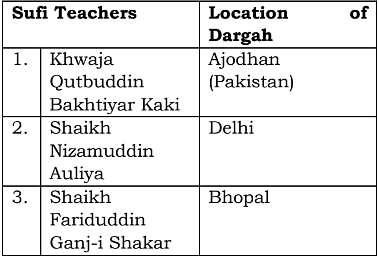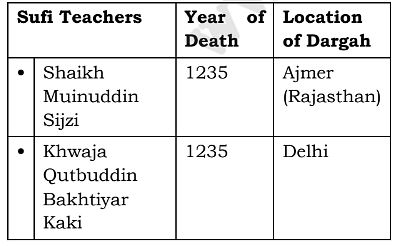GPSC Prelims Paper 1 Mock Test - 8 - GPSC (Gujarat) MCQ
30 Questions MCQ Test - GPSC Prelims Paper 1 Mock Test - 8
Which of the following statements is/are correct with respect to Bindusara?
1. Bindusara is known to have made a gift of elephants to Selukas, Alexander’s ambassador.
2. He was called as Amitragatha (slayer of enemies) by the Greeks.
3. He was assisted by Kautilya in his administration.
Select the correct answer using the code below:
Consider the following statements about the Alvars:
1. The Alvars were the devotees of Shiva.
2. The hymns of the Alvars are compiled in Nalayira Divyaprabandhanam.
Which of the statements given above is/are correct?
| 1 Crore+ students have signed up on EduRev. Have you? Download the App |
Consider the following statements:
1. The chiefs of Southern coastal kingdoms did not collect regular taxes.
2. Satvahanas were also known as lords of the
dakshinapatha, a route leading to South.
3. Sangam poems mention a Tamil word ‘muvendar’ which means sacred river.
Which of the following statements given above is/are correct?
With reference to the Gupta period, consider the following statements:
1. In the Gupta period, Bhagavatism or Vaishnavism over shadowed Mahayana Buddhism.
2. Nalanda became a centre of Buddhist education.
3. In this period, land taxes decreased in number and those on trade and commerce increased.
Which of the statements given above is/are correct?
Consider the following statements about Amir Khusrau:
1. He lived through the reigns of six Sultans of Delhi and was connected with their courts.
2. He created a new style of Persian, which came to be known as Sabaq-i-Hindi.
3. Masnavis are narrative poems, which have great literary and historical value, which have been written by Khusrau.
Which of the statements given above is/are correct?
Consider the following statements about the Medieval India:
Many Saiva sects and centres of learning flourished in Kashmir during the period.
Surgery declined because the dissection of dead bodies was regarded as fit only for the people of low castes.
The Lilawati of Bhaskar-II which was written during this period remained a standard text for medicine.
Which of the statements given above is/are correct?
Consider the following statements:
1. Worship of Bodhisattvas
2. Hollowing out of cave monasteries
3. Development of a new form of Buddhism known as Mahayana Buddhism
4. Buddhist scholars begin to write in Sanskrit
Which of the above statements is/are reasons for the pread of Buddhism?
With reference to ‘Palaeolithic Age’, consider the following statements:
1. The factory sites were the places where hunter and gatherers made wood and bone tools.
2. The Palaeolithic sites have evidence of tools made of limestone.
3. Hunsgi and Kurnool caves are some of the examples of Palaeolithic sites.
Choose the correct answer using the codes given below:
Which of the following statements are correct?
1. Soma was an intoxicating drink made in the Vedic period.
2. It (Soma) was a ritualistic drink.
Select the correct answer using the code given below:
Consider the following statements about Muryan empire:
1. The Arthashastra was written in this period.
2. Some officials were appointed to collect taxes from the people.
3. The spies were appointed to keep a watch on officials.
4. Chandragupta Maurya embraced Buddhism after renouncing his throne.
Choose the correct answer choosing the codes given below:
Consider the following statements about Shankara deva:
1. He was a Shaivite.
2. He composed his poems in Bengali.
3. He began the practice of setting up of Namghars.
Which of the statements given above is/are correct?
Consider the following statements about Tantric practices during Medieval India:
1. Tantric practices were open to women and men, and practitioners often ignored differences of caste and class within the ritual context.
2. Those engaged in Tantric practices frequently ignored the authority of the Vedas.
Which of the statements given above is/are correct?
With respect to Mauryan art and architecture, consider the following statements:
1. The Barabar caves were a gift to the Ajivika sect by Ashoka and his son Dashratha.
2. The Sanchi stupa was originally builtv from stone.
3. The top of the Ashokan pillars display only lion motifs.
Which of the statements given above is/are correct?
Consider the following pairs:

Which of the pairs given above is/are correctly matched?
Consider the following pairs:
1. Lal Ded: Vaishanavite
2. Akka Mahadevi: Shaivite
3. Andal: Shaivite
Which of the pairs given above is/are correctly matched?
Consider the following statements:
1. The Chalukyan rulers of Gujarat
patronized Jainism.
2. The Ganga rulers of Karnataka were great patrons of Jainism.
3. The Paramara rulers of Malwa built many huge images of Jain saints and of Mahavira.
Which of the statements given above is/are correct?
Which of the following statements is/are correct?
1. Kautilya put forward the idea of royal absolutism.
2. The Mauryan army also consisted of a Navy wing.
3. The Mauryan Empire was divided into five provinces, administered by governors.
Select the correct answer using the code given below:
In the context of ancient India, ‘Satamana and Krishnala’ were
Consider the following pairs:
1. Jean Baptiste Tavernier: Vijaynagar Empire
2. Giovanni Careri: Mughal India
3. Francois Bernier: Mughal India
Which of the pairs given above are correctly matched?
Consider the following statements:
1. Amrit-kund had been translated into Persian from Sanskrit.
2. Hindu and Buddhist practices and rituals had been absorbed and assimilated by the Sufis even before they came to India.
Which of the statements given above is/are correct?
Consider the following statements regarding ‘Jatis During Medieval India:
1. Jatis were ranked on the basis of background and occupation of the people.
2. Ranks of Jatis were fixed permanently.
3. Jatis framed their own rules and regulations to manage the conduct of the members.
4. Jatis were required to follow the rules of their village which was governed by a Chieftain.
Which of the statements given above is/are Correct?
Consider the following statements regarding Satavahana dynasty:
1. They followed a metronymic system.
2. Succession to the throne was patrilineal in nature
Which of the statements given above is/are Correct?
In the context of Medieval India the term ‘Vetti’ refer to:
Consider the following statements regarding Kitab Ul-Hind:
1. It was a biography of Sultan Mahmud of Ghazni of Afghanistan.
2. It was written in the Persian language.
3. It contained an account of the people of areas conquered by Sultan Mahmud.
Which of the statements given above is/are Correct?
In context of the challenges faced by the Delhi Sultanate against the Mongols, consider the following statements:
1. Both Allauddin Khilji and Mohammad Bin Tughlaq raised large standing armies and constructed new garrison towns.
2. Administrative measures of Alauddin Khilji were more successful than Mohammad Bin Tughlaq’s.
Which of the statements given above is/are Correct?
In the context of Indo-Islamic architecture in India, consider the following statements:
1. Lapis Lazuli is an inlay technique of using cut and fitted, highly polished colored stones to create images.
2. Pietra Dura is a style of decorating ceilings and carpets with flower motifs and multiple foliations.
Which of the statements given above is/are Incorrect?
Which of the following Sultans of the Tughlaq dynasty issued copper coins instead of silver ones?
Consider the following statements, with reference to Virashaiva traditions:
1. They believed that on death the devotee is united with Shiva, hence they cremated their dead.
2. They opposed widow remarriage.
Which of the statements given above is/are Correct?
Who issued a token currency in copper coins between AD 1329 and 1330?
Muhammad BinTughlaq transferred his capital from



















